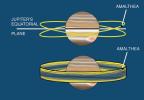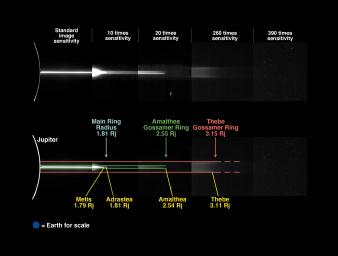This mosaic of five images was taken through the clear filter (610 nanometers) of the solid state imaging system (CCD) aboard NASA's Galileo spacecraft on October 5, 1996. The mosaic is shown twice; the top panel displays only the data, while the bottom panel gives the location of some of Jupiter's small ring moons and presents a match between the image and a simple geometrical model of the gossamer rings. From the spacecraft's distance of approximately 6.6 million kilometers (km), the images have a resolution of about 134 km per pixel (picture element). The images were acquired when Galileo was in Jupiter's shadow, peering back toward the Sun, hidden behind the planet. The spacecraft was located only about 0.15 degrees above the ring plane at the time, making the images highly foreshortened in the vertical direction. North is to the bottom.
The white vertical arc at the left edge of the top panel is caused by sunlight filtering through Jupiter's upper atmosphere; the white horizontal line in the left part of the figure is the main ring whose arms overlap in this foreshortened view. The next frame of the mosaic, taken at higher sensitivity to detect fainter material, shows (on the left part of this panel) the overexposed main ring and the halo (seen as material above and below the main ring) which is interior to the main ring and has become visible in this longer exposure. The middle panel, taken at twenty times the standard sensitivity, shows a tenuous horizontal stripe, which can be made out in the "10 times sensitivity" panel also. In contrast to the main ring, which ends in a narrow elliptical tip, this "gossamer ring" ends abruptly (in the middle of the image) without changing its vertical thickness; the ring is also unusual in that its top and bottom edges are about twice as bright as the central region. Interestingly this ring is only seen to precisely the orbital distance of Amalthea, a small (mean radius of 85 km) Jovian moon, and has a half-thickness that is the same as Amalthea's maximum excursion off Jupiter's equatorial plane.

Satellite Interactions with Jupiter's Ring System
Further to the right, using much higher sensitivities, another faint but wider stripe becomes visible. This last band is associated with Thebe, a Jovian moon with a mean radius of 50 km. The ring lies principally inside Thebe's orbit and has a thickness like Thebe's elevation above Jupiter's equatorial plane. Given the position of Adrastea (in the equatorial plane at the periphery of the main Jovian ring), the main ring is likely derived from this small satellite (mean radius of 8 km).
The bottom rendition shows the orbital distances (in yellow) of the small satellites. The distances are given in units of Jovian radii; Jupiter's radius is 71,398 kilometers (44,267 miles). Various components of the Jovian ring system are plotted as seen from the equatorial plane: the green band represents the positions of particles lost from Amalthea; the red band is material from Thebe.
The Jet Propulsion Laboratory, Pasadena, CA manages the Galileo mission for NASA's Office of Space Science, Washington, DC.
This image and other images and data received from Galileo are posted on the World Wide Web, on the Galileo mission home page at URL http://solarsystem.nasa.gov/galileo/. Background information and educational context for the images can be found at URL http://www.jpl.nasa.gov/galileo/sepo.

 Planetary Data System
Planetary Data System













